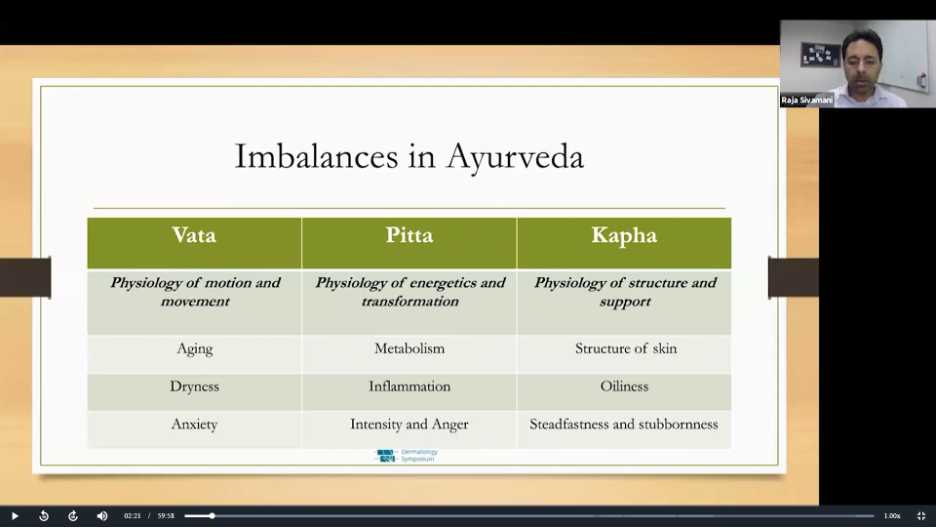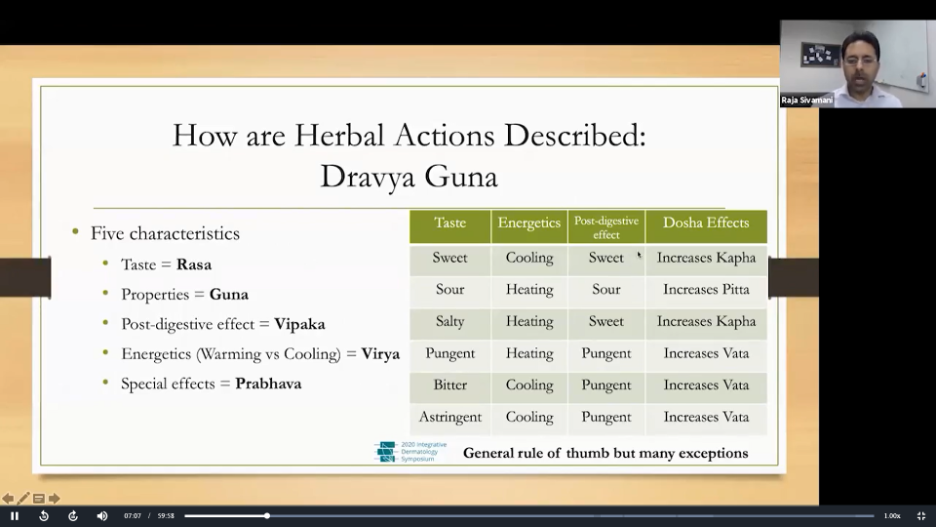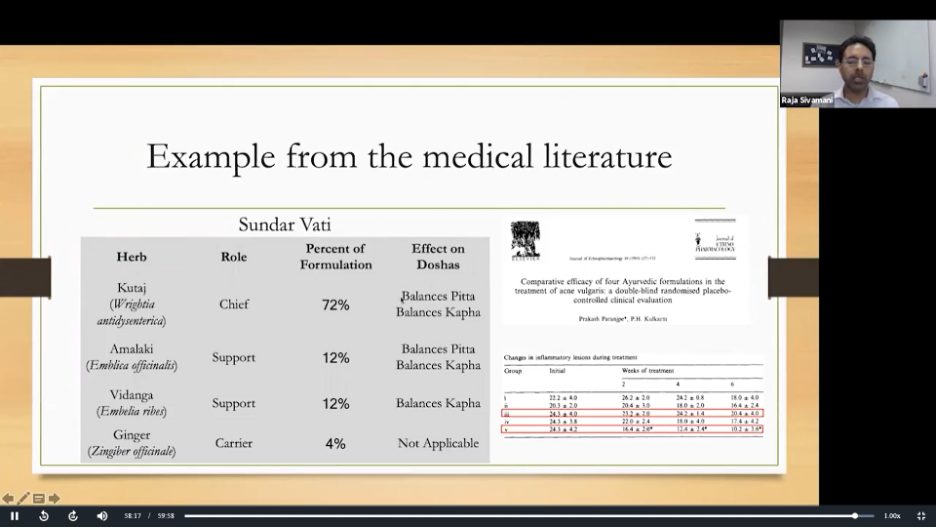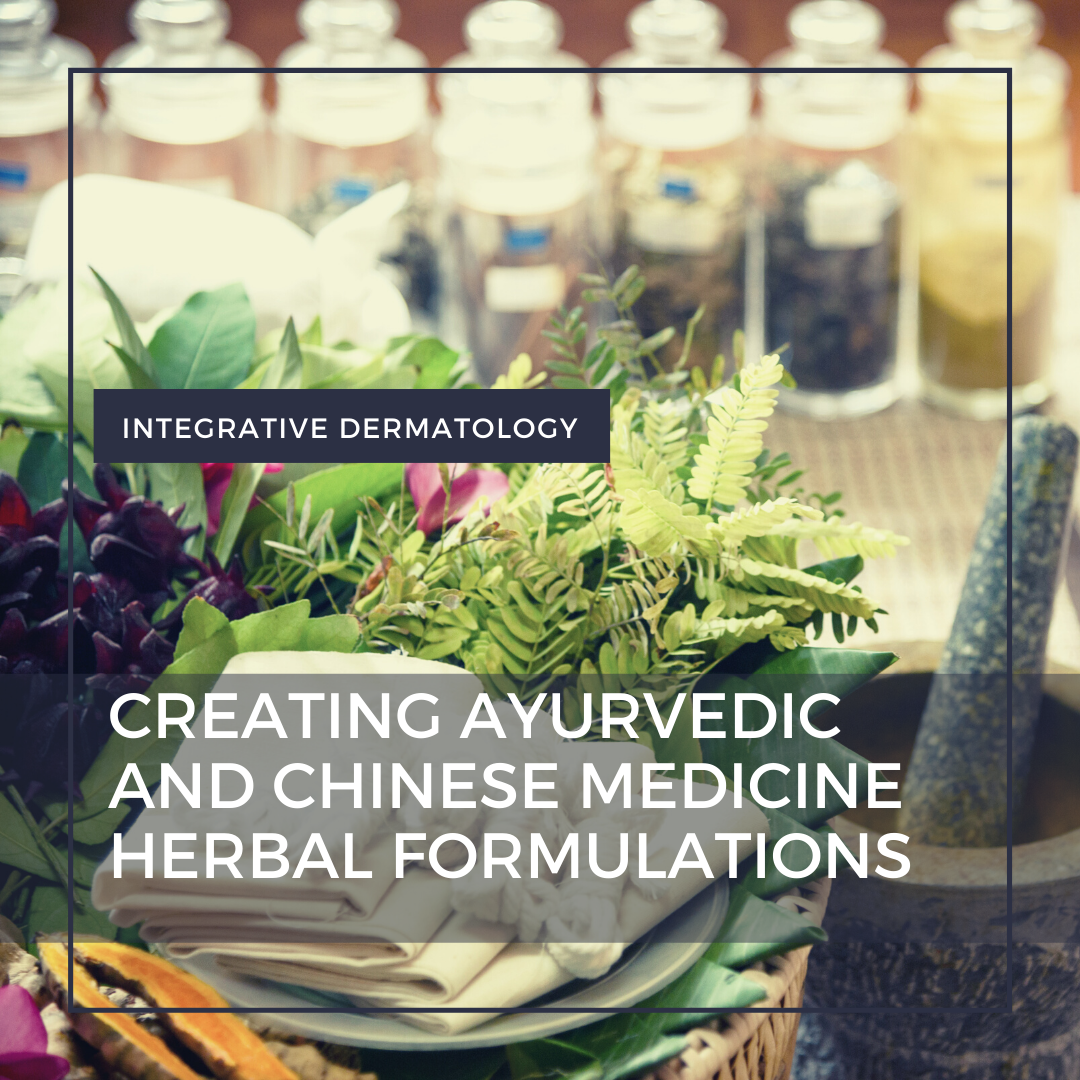My patient asks about turmeric, neem oil, cardamom, etc. I stubble through what I know. I am a “western-style” physician. I could be cast alongside Eastwood or the Duke (or maybe more accurately Cleavon Little in Blazing Saddles). Anyways, if you are like me and need the crash course, look no further! Before this lecture, I had never heard of Ayurvedic medicine (amazing what we don’t know). While you may never practice this style of medicine this review should help you with some basics so you can speak intelligently about certain herbals – and maybe even be able to help a patient understand which ones may be of benefit.
During the 2020 Integrative Dermatology Symposium, Amy Branum, AHP and Dr. Raja Sivamani, share a primer on Ayurveda and discuss 10 herbals, in their presentation – Workshop: Case Based Approach to Creating Ayurvedic and Chinese Medicine Herbal Formulations.
This review will provide an overview of the talk, including:
-
- A brief discussion of Ayurvedic Medicine and the 3 physiological energies
- Imbalances in the 3 physiologic energies
- 10 herbals, what their main functions are, dosing, and expert advise
Before we get into the full review, here are my “Ah-ha moments” – what I took away from the lecture that I found intriguing:
-
- We should open our minds to alternative methods, and at least know how to find alternative medicine practitioners for patients who desire this. (Where should you turn? Keep reading!)
- It doesn’t have to be complex. You can learn some basics that can help – especially when discussing these with patients (Simple? Well some basics are! Take a look!)
- Dosing and vehicle (powder, oil, etc.) make a difference (Looking for recommendations? Look below!)
Ayurveda – the 3 physiologic energies – Vata, Pitta, Kapha
Ayurvedic Medicine (AM) has been practiced for about 5000 years – making it arguably the oldest healing science. This article will touch upon one aspect of AM – utilizing herbs to treat imbalances in the 3 physiologic energies (doshas) as well as holistic clinical symptomatology. Treatments utilize individually composed formulations of many herbs to create a treatment for the specific patient’s symptomatology. Further information can be found here – https://www.ayurveda.com/resources/articles/ayurveda-a-brief-introduction-and-guide
To simplify, Dr. Sivamani discussed that the idea of Vata, Pitta, and Kapha is to describe where on a 3D graph the patient’s imbalances in health place the patient away from their center/balance. This then allows the practitioner to prescribe balancing herbals and other treatments. Mrs. Branum discussed that herbals fall into general categories – adaptogens (helps to deal with stress), anti-inflammatories, demulcent (soothing), astringent (have a tightening effect on tissues), and carminative (ease GI system and gas). Dr. Simavani shares that there are five characteristics of specific herbs: taste, properties, post-digestive effects, energetics, and special effects. See slides below for these simplified versions of AM physiologic energies.


10 Herbs to start with
-
- Tumeric – Taste: Bitter, pungent, astringent – Energetics: Warming – Effect on Doshas: balances pitta (inflammation) and kapha (oiliness, etc). Astringent and anti-inflammatory. Powder is made from the root. Whole turmeric does not need an extra agent to help it absorb, curcumin needs an agent like black pepper or cardamom to help it absorb. Hydrogenating the turmeric will make it colorless. Can be found in powder form or capsules. Dosage needs to be high for anti-inflammatory – 2,000 to 6,000 mg (2 capsules 3 times per day – each capsule is about 500mg) or about ¾ teaspoon or powder 2-3 times per day.
- Amalaki – Taste: sour, sweet, astringent – Energetics: Cooling – Effect on Doshas: balances pitta (inflammation) and vata (dryness, etc). Adaptogen and anti-oxidant, powder made from the fruit. Good for patients with dryness and inflammation. Used a lot in skin care as an anti-inflammatory. Used as a laxative for clearing. Also used for pre-mature greying of the hair – must be used for months but no studies to confirm this affect. Can be found in powder form or capsules. Dosage – 2,000 to 6,000 mg (2 capsules 3 times per day – each capsule is about 500mg) or about ½ – ¾ teaspoon 2-3 times per day.
- Neem – Taste: Bitter, astringent – Energetics: Cooling – Effect on Doshas: balances pitta and kapha. Astringent and anti-microbial, powder made from the leaves. Can be used in oil or powder form. Dr. Sivamani uses it for patients with atopic dermatitis as a topical moisturizer. He has the patient use 4 parts coconut oil and 1 part neem powder. Gently heat the coconut oil (stove top or crockpot) then place the herb in and let it cool then push through a cheese cloth to remove the herb after extraction of the oil soluble properties. You can also just use the oil extract. One could just make a tea of neem and place on a cloth and apply to the skin. Another option is to just place fine powder into a cream (can be compounded this way). With topical use this may help balance the microbiome.
- Gotu Kola – Taste: Bitter, sweet, astringent – Energetics: Cooling – Effect on Doshas: balances pitta and vata. Adaptogen, powder made from the leaves. Good in teas or oral supplementation for memory and calming. Topically used in ointments and oils for increasing collagen production, healing properties, burns, wound healing, and irritated rashes. Sivamani mentions an in-vitro study that showed increased sebaceous gland function with Gotu Kola. He also mentions using this for scars and stretch marks. Dr. Sivamani mentions a study that showed trend towards improvement with Gotu Kola mixed with lipoderm at 1% Gotu Kola.
- Gurmar / Shardunika – Taste: Sour, sweet, astringent – Energetics: Cooling – Effect on Doshas: balances kapha. Powder made from the leaves. Blocks sugar receptor taste buds and also blocks absorption of sugar in the intestines. So, if taken by a powder you will not taste sugar for about 1-4 hours. Good for patients with diabetes as it can increase insulin levels. Reduces sweet cravings. Dosing – powder ½ teaspoon twice daily or 500mg capsule twice daily (capsule will not knock out sugar receptors). Sivamani likes to use it for acne.
- Cardamom – Taste: Pungent, sweet – Energetics: Warming – Effect on Doshas: balances vata and kapha. Can aggravate pitta given the warming effects. Carminative – relieves flatulence and helps with digestion of other herbs and foods. Can take it after a meal to help with digestion. Comes in pods or powders. Helpful with sleep.
- Triphala – mixture of 3 herbs (Haritaki, Babhitaki, Amalaki) – Taste: Pungent, sour, sweet, bitter, astringent – Energetics: Neutral – Effect on Doshas: balances vata, pitta and kapha. Is a Rasayana (for invigorating the body). Used for gut health – Dr. Sivamani discussed a study done which showed a pre-biotic effect of this triple herb. Good anti-oxidant. Dosing was 2,000 mg a day – ½ teaspoon twice a day. Also helps with constipation.
- Guduchi – Taste: Bitter, astringent, sweet, pungent – Energetics: Warming – Effect on Doshas: balances vata and kapha. Is a Rasayana (for invigorating the body). Adaptogen and anti-inflammatory. Heating but does not aggravate pitta. Powder from stems. Used in diabetic regimens. Is a diuretic so use with caution with concomitant diuretics or underlying kidney disease. Also called “heart-leaved moonseed”. Also, good to add in for acne.
- Shatavari – Taste: Bitter, sweet – Energetics: Cooling – Effect on Doshas: balances vata and pitta. Adaptogen, demulcent, and anti-oxidant. Power from roots. Traditionally used for reproductive vitality. Also known as a women’s herb – literally translates to “she who has 100 husbands”. Calms and strengthens the nervous system. Also used to hold more water in tissues. Can be used topically – around 1-2% for topicals – used around the genitals for rejuvenative treatment or for the face as an anti-oxidant.
- Manjistha – Taste: Sweet, bitter, astringent – Energetics: Cooling – Effect on Doshas: balances pitta and kapha. Astringent and anti-inflammatory. Power from roots. Thought to remove excess heat (pitta0 from the body. Can cause urine and tears to turn slightly red – can also stain clothes. Some pre-biotic effects on the GI microbiome in studies. Can be used for acne topically or orally. Oral dosage – 1000mg daily increase to twice daily if tolerated.
Creating an Herbal Formulation
-
- Overall approach – Chief herb(s), supportive herbs, and carrier herbs
- Chief herb – most important herb that has the main intent of balancing the doshas
- Support herb – supports the balance of doshas that may address a more minor issues
- Carrier herb – helps with absorption of other herbs (
- 4 parts chief herb – 2 parts supportive – 1 part carrier is typical but frequently customized for each patient
- Prakruti (balanced state – your natural balance for you) and Vikruti (imbalanced state – what your current state might be)
- Want to learn more? A good starting point is this book: The Yoga of Herbs – https://www.amazon.com/Yoga-Herbs-Ayurvedic-Herbal-Medicine/dp/0941524248
- There are thousands of herbs – select a few that fit into different categories of action and learn those well
- If you are serious about learning more about Ayurveda, take a course.
Let’s take Acne as a Disease State Approach to Herbal Use
-
- In general, acne is an imbalance of kapha (oil production – clogging of pores) and pitta (inflammation) – both are too elevated
- Pitta dominant – inflammatory papules and nodules
- Kapha dominant – open comedones and plugged follicles
- For Kapha (low inflammation – plugged pores) – we might choose herbals with more astringent and anti-microbial properties. Manjistha (chief), neem (chief), shardunika (support), turmeric/cumin/cardomon/amalaka (support/carrier)
- For Pitta (high inflammatory lesions) – Manjistha (chief), shatavari/turmeric/neem (support), and fennel (carrier)
- These would all be done orally – possibly use neem topically

Rosacea as a Disease State Approach to Herbal Use
-
- Rosacea is more of an imbalance of pitta (inflammation) and vata (dryness and irritation)
- For rosacea – consider – Turmeric (chief), Amlaki (support), and Gotu Kola topically
Final Thoughts
-
- As an area with minimal formal research it can be tough to know where to turn for information and who/what to believe
- Our patients will look to us (or avoid us) for our opinion – depending on your level of comfort
- It would seem wise to at least have some working knowledge of the basics when our patients are asking about supplements to their western-style care
- If your patient is looking for an Ayurvedic practitioner – https://ayurvedanama.site-ym.com/search/custom.asp?id=945
Are you recommending alternative treatments to your patients? What herbals are you recommending for patients at this time? Have you/they had success?
Please share your comments and join the discussion at the end of this post, and on Instagram @nextstepsinderm!
Amy Branum, AHP is an herbalist and Ayurvedic health practitioner. She currently teaches herbal programs at The Wild Temple School of Yoga and Herbal Wisdom and has a clinical practice, Lasya Wellness and Vitality, in Grass Valley, CA.
Dr. Raja Sivamani, MD, MS, AP is board-certified dermatologist and an Ayurvedic Practitioner. He runs a medical practice (Pacific Skin Institute) and an integrative and aesthetic practice (Zen Dermatology) and heads a clinical trials unit at both locations. He is an Adjunct Associate Professor of Clinical Dermatology at the University of California Davis and a Co-Director of the Microbiome Research Initiative and serves as the co-chair of the annual Integrative Dermatology Symposium.
The above article was written by Dr. James J. Contestable, Derm In-Review Advisory Council member, and represents his interpretation of the information presented by Mrs. Branum and Dr. Sivamani during their lecture ” Creating Ayurvedic and Chinese Medicine Herbal Formulations” presented at the 2020 Integrative Dermatology Symposium.
Did you enjoy this article? Find more on Integrative Dermatology here.

